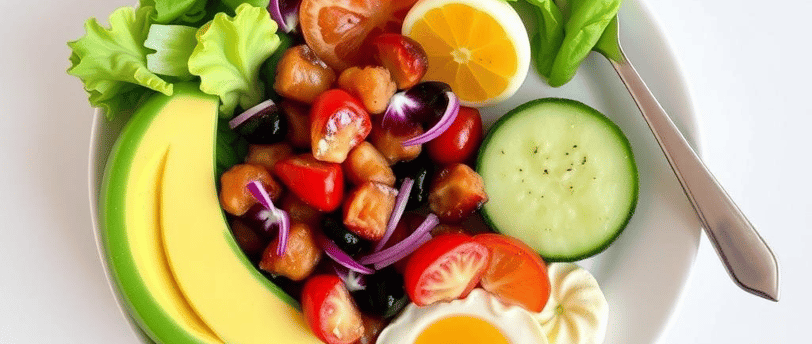How to Create a Balanced Meal Plan in Under 30 Minutes
🧘WELLNESS TIPS


In a world where time seems to slip through our fingers, creating a balanced meal plan can feel daunting. But it doesn't have to be! With just a little organization and a dash of creativity, you can whip up a nutritious meal plan in under 30 minutes. Whether you’re a busy professional, a parent juggling multiple responsibilities, or simply someone who wants to eat healthy without a major time commitment, this guide is for you. Let’s dive into how to craft a well-rounded meal plan that caters to your nutritional needs and fits your lifestyle.
Understanding Balanced Meals
Before we jump into the planning process, it’s essential to understand what makes a meal balanced. A balanced meal typically includes:
Proteins: Vital for muscle repair and immune function. Think lean meats, legumes, tofu, and dairy products.
Carbohydrates: Your body's primary energy source. Including whole grains, fruits, and vegetables is key for fiber and nutrients.
Fats: Healthy fats are crucial for brain health and hormone production. Incorporate avocados, nuts, seeds, and olive oil.
Vitamins and Minerals: Fruits and vegetables provide essential nutrients. Aim for a colorful array to cover your nutritional bases.
Step 1: Set Your Goals
Take a moment to define your culinary goals. Are you looking to lose weight, gain muscle, or simply eat healthier? Having a clear objective can guide your meal choices and help you determine which foods to emphasize in your plan. Make sure to consider:
Diet Preferences: Vegan, vegetarian, gluten-free? Choose options that resonate with your dietary lifestyle.
Family Needs: Take into account any allergies or preferences from family members. Involving everyone in the meal planning process can foster excitement and cooperation.
Step 2: Inventory Your Pantry and Fridge
Before you create a meal plan, it’s wise to take stock of what you already have. Check your pantry and refrigerator for ingredients that need to be used up. Not only will this save you money, but it’ll also help reduce food waste. Make a list of:
Proteins: Canned beans, frozen chicken, eggs, etc.
Grains: Rice, pasta, quinoa, etc.
Fruits and Vegetables: Fresh, frozen, or canned.
Condiments and Spices: These can add flavor without adding significant calories.
Step 3: Choose Your Recipes
Once you have a solid understanding of your goals and what’s available, start brainstorming recipes. Aim for simplicity and aim to include diverse ingredients. Websites and apps like Pinterest, Yummly, or even your favorite cooking blogs can provide inspiration. Here are quick meal ideas to get your creativity flowing:
Breakfast: Overnight oats, smoothies, scrambled eggs with spinach, or yogurt parfaits.
Lunch: Quinoa salad with roasted vegetables, turkey and hummus wrap, or a hearty veggie soup.
Dinner: Stir-fry with chicken and mixed vegetables, baked salmon with quinoa and asparagus, or a lentil stew with crusty bread.
Snacks: Fresh fruit, nuts, hummus with carrot sticks, or whole-grain crackers with cheese.
Step 4: Create Your Template
Now that you have your recipes, it’s time to succinctly organize them into a meal planning template. You can create a simple chart or use meal planning apps to visualize your plan.
Step 5: Grocery List and Shopping
Now that your meal plan is complete, creating a grocery list is a breeze. Group items by type to make your shopping trip more efficient. A well-organized grocery list can save you additional time and prevent impulse buys.
Note: It can also be helpful to check local sales or seasonal produce. Planning your meals around what’s discounted can save money and ensure freshness.
Step 6: Prep Time
Once you have your ingredients at home, you might want to allocate some time on your weekend or a less busy day to do some prep work. Spend an hour or two washing, chopping, and storing ingredients in your fridge. This makes it easier to throw meals together during the week. Here’s a simple checklist for meal prep:
Pre-chop veggies: Carrots, peppers, onions, and more for easy access.
Cook proteins in batches: Roast chicken or cook quinoa ahead of time.
Make sauces or dressings: This can save time and enhance flavors throughout the week.
Step 7: Stay Flexible
Life is unpredictable! While having a meal plan is beneficial, it’s equally important to remain flexible. If something comes up, don’t hesitate to swap meals around or even use leftovers creatively. This adaptability will keep your meal planning enjoyable rather than stressful.
Final Thoughts
Creating a balanced meal plan doesn’t have to consume your entire evening. With planning, organization, and some creativity, you can enjoy delicious, nutritious meals throughout the week—all within a 30-minute time frame. Embrace the journey and make it fun! After all, meal planning is not just about food; it’s about nurturing yourself and those you love. Happy planning!
